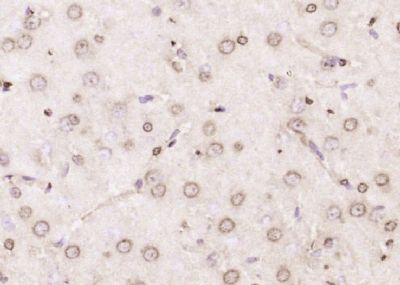GRASP65 Polyclonal Antibody
Purified Rabbit Polyclonal Antibody (Pab)
- SPECIFICATION
- CITATIONS
- PROTOCOLS
- BACKGROUND

Application
| WB, IHC-P, IHC-F, IF, E |
|---|---|
| Primary Accession | Q9BQQ3 |
| Reactivity | Rat, Pig, Dog, Bovine |
| Host | Rabbit |
| Clonality | Polyclonal |
| Calculated MW | 46 KDa |
| Physical State | Liquid |
| Immunogen | KLH conjugated synthetic peptide derived from human GRASP65 |
| Epitope Specificity | 1-100/440 |
| Isotype | IgG |
| Purity | affinity purified by Protein A |
| Buffer | 0.01M TBS (pH7.4) with 1% BSA, 0.02% Proclin300 and 50% Glycerol. |
| SUBCELLULAR LOCATION | Golgi apparatus, cis-Golgi network membrane; |
| SIMILARITY | Belongs to the GORASP family. Contains 1 PDZ (DHR) domain. |
| SUBUNIT | Homodimer. Forms higher order oligomers under interphase but not mitotic conditions. Dimers of the protein on one membrane might be able to interact with dimers on another and so stack cisternae. Interacts with the C-terminus of GM130 under both mitotic and non-mitotic conditions. The interaction is critical for the correct targeting of both proteins to the cis-Golgi. The complex binds to the vesicle docking protein p115. Interacts with TMED2 and TMED3 (By similarity). |
| Post-translational modifications | Phosphorylated by CDC2/B1 and PLK kinases during mitosis. Phosphorylation cycle correlates with the cisternal stacking cycle. Phosphorylation of the homodimer prevents the association of dimmers into higher order oligomers, leading to cisternal unstacking.Target for caspase-3 cleavage during apoptosis. The cleavage contributes to Golgi fragmentation and occurs very early in the execution phase of apoptosis (By similarity). |
| Important Note | This product as supplied is intended for research use only, not for use in human, therapeutic or diagnostic applications. |
| Background Descriptions | Stacking factor involved in the postmitotic assembly of Golgi stacks from mitotic Golgi fragments. Key structural protein required for the maintenance of the Golgi apparatus integrity: its caspase-mediated cleavage is required for fragmentation of the Golgi during apoptosis. Also mediates, via its interaction with GM130, the docking of transport vesicles with the Golgi membranes. |
| Gene ID | 64689 |
|---|---|
| Other Names | Golgi reassembly-stacking protein 1, Golgi peripheral membrane protein p65, Golgi phosphoprotein 5, GOLPH5, Golgi reassembly-stacking protein of 65 kDa, GRASP65, GORASP1, GOLPH5, GRASP65 |
| Dilution | WB=1:500-2000,IHC-P=1:100-500,IHC-F=1:100-500,IF=1:100-500,ELISA=1:5000-10000 |
| Format | 0.01M TBS(pH7.4), 0.09% (W/V) sodium azide and 50% Glyce |
| Storage | Store at -20 ℃ for one year. Avoid repeated freeze/thaw cycles. When reconstituted in sterile pH 7.4 0.01M PBS or diluent of antibody the antibody is stable for at least two weeks at 2-4 ℃. |
| Name | GORASP1 |
|---|---|
| Synonyms | GOLPH5, GRASP65 |
| Function | Key structural protein of the Golgi apparatus (PubMed:33301566). The membrane cisternae of the Golgi apparatus adhere to each other to form stacks, which are aligned side by side to form the Golgi ribbon (PubMed:33301566). Acting in concert with GORASP2/GRASP55, is required for the formation and maintenance of the Golgi ribbon, and may be dispensable for the formation of stacks (PubMed:33301566). However, other studies suggest that GORASP1 plays an important role in assembly and membrane stacking of the cisternae, and in the reassembly of Golgi stacks after breakdown during mitosis (By similarity). Caspase-mediated cleavage of GORASP1 is required for fragmentation of the Golgi during apoptosis (By similarity). Also mediates, via its interaction with GOLGA2/GM130, the docking of transport vesicles with the Golgi membranes (PubMed:16489344). Mediates ER stress-induced unconventional (ER/Golgi-independent) trafficking of core-glycosylated CFTR to cell membrane (PubMed:21884936). |
| Cellular Location | Golgi apparatus, cis-Golgi network membrane; Peripheral membrane protein; Cytoplasmic side. Endoplasmic reticulum- Golgi intermediate compartment membrane |

Thousands of laboratories across the world have published research that depended on the performance of antibodies from Abcepta to advance their research. Check out links to articles that cite our products in major peer-reviewed journals, organized by research category.
info@abcepta.com, and receive a free "I Love Antibodies" mug.
Provided below are standard protocols that you may find useful for product applications.
If you have used an Abcepta product and would like to share how it has performed, please click on the "Submit Review" button and provide the requested information. Our staff will examine and post your review and contact you if needed.
If you have any additional inquiries please email technical services at tech@abcepta.com.













 Foundational characteristics of cancer include proliferation, angiogenesis, migration, evasion of apoptosis, and cellular immortality. Find key markers for these cellular processes and antibodies to detect them.
Foundational characteristics of cancer include proliferation, angiogenesis, migration, evasion of apoptosis, and cellular immortality. Find key markers for these cellular processes and antibodies to detect them. The SUMOplot™ Analysis Program predicts and scores sumoylation sites in your protein. SUMOylation is a post-translational modification involved in various cellular processes, such as nuclear-cytosolic transport, transcriptional regulation, apoptosis, protein stability, response to stress, and progression through the cell cycle.
The SUMOplot™ Analysis Program predicts and scores sumoylation sites in your protein. SUMOylation is a post-translational modification involved in various cellular processes, such as nuclear-cytosolic transport, transcriptional regulation, apoptosis, protein stability, response to stress, and progression through the cell cycle. The Autophagy Receptor Motif Plotter predicts and scores autophagy receptor binding sites in your protein. Identifying proteins connected to this pathway is critical to understanding the role of autophagy in physiological as well as pathological processes such as development, differentiation, neurodegenerative diseases, stress, infection, and cancer.
The Autophagy Receptor Motif Plotter predicts and scores autophagy receptor binding sites in your protein. Identifying proteins connected to this pathway is critical to understanding the role of autophagy in physiological as well as pathological processes such as development, differentiation, neurodegenerative diseases, stress, infection, and cancer.


